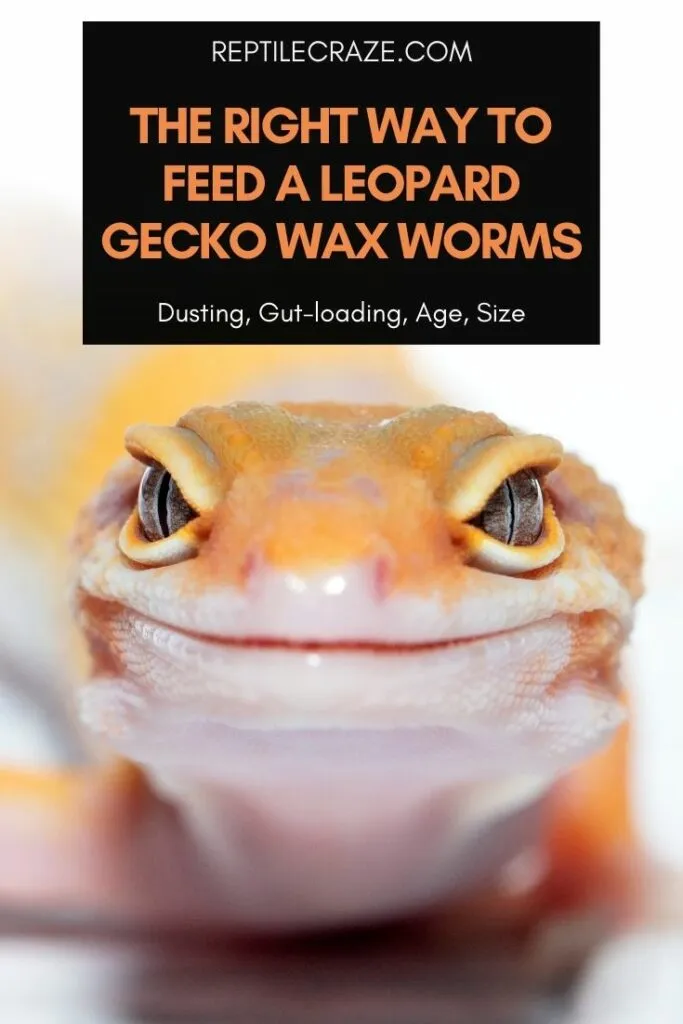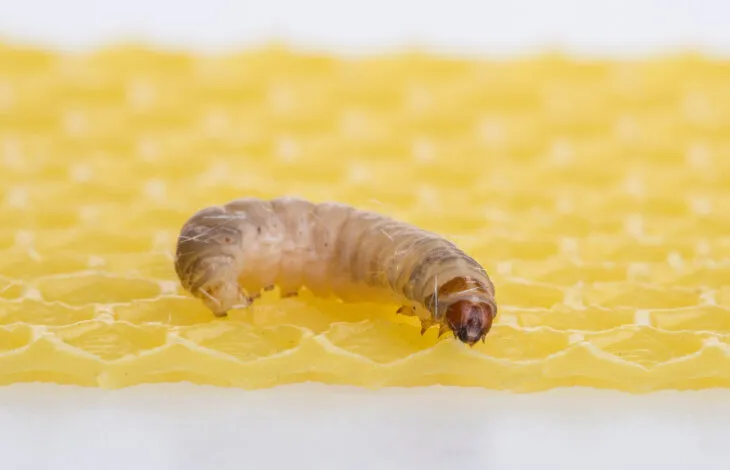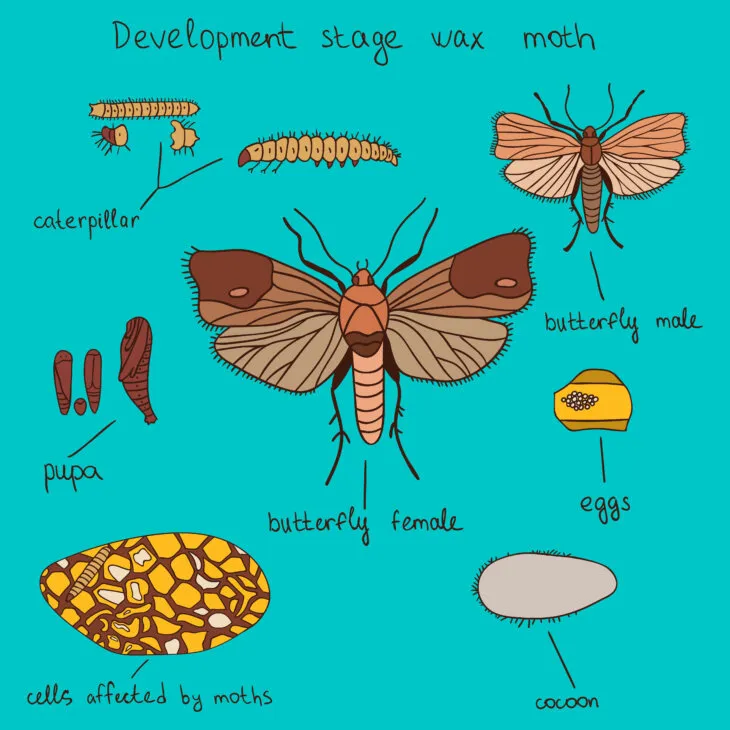
Leopard Gecko owners like myself love treating their pets to the occasional wax worm (Galleria mellonella). But what is the right way to feed wax worms to Leopard Geckos?
Leopard Geckos should be fed wax worms that are smaller than the space between their eyes. The wax worms should be plump, pale, and wriggling. Either hand feed the wax worms or deliver on a clean surface such as a feeding dish. Wax worms can be gut-loaded and dusted with calcium and vitamin powder.
That’s the quick answer, but let’s find out more about how to choose, prepare, and provide wax worms for your Leopard Gecko.
Table of Contents
Choose The Right Sized Wax Worm For Your Leopard Gecko
The first step to picking a good wax worm for your Leopard Gecko is to assess the size. You should only give your Leopard Gecko wax worms that are smaller than the width between their eyes.
This is because the width between their eyes is a good indicator of the width of their throat. This technique helps reduce the chances of your Leopard Gecko choking or suffering a digestive impaction.
Choose A Healthy Wax Worm For Your Leopard Gecko
The second step is to assess the quality of the wax worm. A good wax worm should be wriggling about. It should be plump and pale in color.
Also, check the package that the wax worms live in. It shouldn’t be slimy or smelly. There shouldn’t be any mold.
Don’t feed your Leopard Gecko any wax worm that is injured, dried up, not moving, or otherwise looks unwell. It could be sick or dead and pass bacteria to your Leopard Gecko.

How to Give Wax Worms To Your Leopard Gecko
Leopard Geckos love eating wax worms and will probably take them any way you give them. But, some ways are better than others.
It’s not a good idea to simply throw them in the
Also, the worm might get lost in the
You could deliver the worms by placing them on a rock or log. You could also provide them in a feeding tray or shallow bowl.
My preferred way to feed wax worms is by hand during training sessions. If I am working on building trust, this is a great opportunity to feed my leopard geckos their favorite treat using tongs or fingers.
Should You Dust Wax Worms For Leopard Geckos?
Yes, dusting wax worms before feeding them to your Leopard Gecko is a good idea. Wax worms contain very little nutritional value. Dusting them with calcium powder, such as this one here will mean that they get a little more nourishment.
Calcium powder will also help to correct the inverse calcium-phosphorus ratio of wax worms. This will help prevent metabolic bone disease in your Leopard Gecko (Kolb, 2017).
Should You Gut Load Wax Worms For Your Leopard Geckos?
While gut loading the wax worms sounds like a good way to increase their nutritional value in theory, it’s actually not necessary. Wax worms aren’t really worms, they are the larval stage of the honeycomb moth (Galleria mellonella).
The honeycomb moth parasitizes beehives and lays its eggs inside. So, wax worms naturally eat beeswax and honey. In captivity, wax worms are fed honey, glycerin, and cereals.
As none of these things are beneficial to your Leopard Gecko, there isn’t any need to gut load the wax worms.

How To Gut Load Wax Worms For You Leopard Geckos
As discussed above, it’s not really necessary to gut load wax worms before feeding them to your Leopard Gecko. For one, wax worms only eat beeswax and honey.
Secondly, they aren’t a staple part of your leopard geckos diet and don’t need to prove their core nutrition. Think of them as cookies.
But, if you’re really keen to maximize their nutritional potential, you can gut load them with this trick. Blend together a mixture of honey, glycerin, and organic oat baby cereal.
Add some vitamin powder such as this one into the mixture.
The wax worms will eat up this mixture (or not, they can go a long time without any
Bear in mind, though, that he will also consume the calorific honey and grains. This increases the calorific value of the already-fatty wax worms.
Should You Mist Wax Worms So That Your Leopard Gecko Gets A Drink?
I like to give wax worms a quick misting of fresh, clean water just before feeding them to my Leopard Gecko. The rinsing helps wash away any contaminants from the wax worms’ substrate.
But, don’t introduce water to the wax worms’ habitat. It will cause molding.
Leopard Geckos take most of their water from their
Can You Feed Wax Worm Pupae To Leopard Geckos?
After their larval life stage (when they look like fat, pale worms), the wax worms will begin to spin a silk cocoon.
When they enclose themselves in the cocoon, they undergo the transformation into a honeycomb moth. At this stage, they are called pupae.
You can feed your Leopard Geckos newer pupae that are still very soft on the outside. But, as they harden, they will become more and more difficult to digest. This could risk causing an impaction.
The wax worms darken as they turn into pupae. If you feed dark-colored wax worms to your Leopard Gecko there may be some confusion over what is a pupating wax worm and what is a dying wax worm.
If you want more details on how to know what wax worms your Leopard Gecko can eat, click here to read our in-depth article!
Can You Leave Wax Worms In Your Leopard Gecko Tank Overnight?
No, live feeder insects should never be left unsupervised in your Leopard Gecko’s
Feeder insects may even cause injury to your Leopard Geckos. At night, there is a chance they might bite them, which could result in an infected wound.
If your Leopard Gecko doesn’t eat them, they may crawl away and get lost.
Eventually, they will either die and rot, or transform into a flying moth. To find out why your Leopard Gecko isn’t eating his wax worms, read our in-depth guide here.
- Enchi Ball Python: A Unique and Stunning Morph of Python regius - March 27, 2025
- Emerald Tree Monitor: The Enigmatic Green Guardian of the Rainforest - March 26, 2025
- The Egyptian Cobra (Naja haje): A Fascinating Serpent - March 25, 2025
